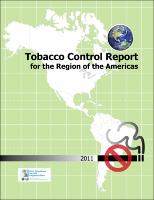Tobacco Control Report for the Region of the Americas. 2011
| dc.contributor | Centers for Disease Control and Prevention | en_US |
| dc.date.accessioned | 2015 | |
| dc.date.available | 2015 | |
| dc.date.issued | 2011 | |
| dc.identifier.isbn | 9789275116340 | |
| dc.identifier.uri | https://iris.paho.org/handle/10665.2/7673 | |
| dc.description.abstract | Tobacco is one of the world’s leading causes of preventable death and is responsible for roughly 1 million deaths annually in the Americas. It is a risk factor for six of the eight leading causes of death, and it is the only legal product that kills from one-third to one-half of those who use it exactly as intended by the manufacturer. Tobacco not only harms the smoker; there is sufficient scientific evidence that exposure to second-hand smoke causes illness and death in nonsmokers as well. Reducing tobacco use will save millions of lives and reverse the entirely preventable tobacco epidemic. Unanimously adopted by the 56th World Health Assembly on 21 May 2003, the WHO Framework Convention on Tobacco Control (WHO FCTC) was the first step in the global fight against the tobacco epidemic. The Convention entered into force on 27 February 2005. Of the 193 WHO Member States, 174 are Parties to the Convention (July 2011), making it one of the most rapidly embraced treaties in United Nations history. The treaty presents a blueprint for countries to reduce both the supply of and demand for tobacco... | en_US |
| dc.language.iso | en | es_ES |
| dc.publisher | PAHO | es_ES |
| dc.subject | Tobacco Control | es_ES |
| dc.subject | Consumo de Productos Derivados del Tabaco | es_ES |
| dc.title | Tobacco Control Report for the Region of the Americas. 2011 | en_US |
| dc.type | Publications | en_US |
| dc.rights.holder | Pan American Health Organization | en_US |
| dc.contributor.corporatename | Pan American Health Organization | en_US |
| paho.publisher.country | United States | es_ES |
| paho.publisher.city | Washington, D.C | es_ES |
| paho.source.centercode | US1.1 | es_ES |




